Chapter 6H. Typical Applications
Notes for Figure 6H-24—Typical Application 24
Half Road Closure on Far Side of Intersection
Guidance:
- If the work space extends across a crosswalk,
the crosswalk should be closed using the information and devices
shown in Figure 6H-29.
- When turn prohibitions are implemented, two
turn prohibition signs should be used, one on the near side and,
space permitting, one on the far side of the intersection.
Option:
- A buffer space may be used between opposing directions
of vehicular traffic as shown in this application.
- The normal procedure is to close on the near
side of the intersection any lane that is not carried through
the intersection. However, if there is a significant right-turning
movement, then the right lane may be restricted to right turns
only, as shown.
- Where the turning radius is large, a right-turn
island using channelizing devices or pavement markings may be
used.
- There may be insufficient space to place the
back-to-back Keep Right sign and No Left Turn symbol signs at
the end of the row of channelizing devices separating opposing
vehicular traffic flows. In this situation, the No Left Turn symbol
sign may be placed on the right and the Keep Right sign may be
omitted.
- For intersection approaches reduced to a single
lane, left-turning movements may be prohibited to maintain capacity
for through vehicular traffic.
- Flashing warning lights and/or flags may be used
to call attention to advance warning signs.
- Temporary pavement markings may be used to delineate
the travel path through the intersection.
Support:
- Keeping the right lane open increases the through
capacity by eliminating right turns from the open through lane.
- A temporary turn island reinforces the nature
of the temporary exclusive right-turn lane and enables a second
RIGHT LANE MUST TURN RIGHT sign to be placed in the island.
Figure
6H-24 Half Road Closure on Far Side of Intersection (TA-24)
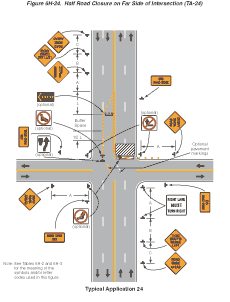
Notes for Figure 6H-25—Typical Application 25
Multiple Lane Closures at Intersection
Guidance:
- If the work space extends across a crosswalk,
the crosswalk should be closed using the information and devices
shown in Figure 6H-29.
- If the left through lane is closed on the near-side
approach, the LEFT LANE MUST TURN LEFT sign should be placed in
the median to discourage through vehicular traffic from entering
the left-turn bay.
Option:
- The normal procedure is to close on the near
side of the intersection any lane that is not carried through
the intersection. If the left-turning movement that normally uses
the closed turn bay is small and/or the gaps in opposing vehicular
traffic are frequent, left turns may be permitted on that approach.
- Flashing warning lights and/or flags may be used
to call attention to the advance warning signs.
Figure
6H-25 Multiple Lane Closures at Intersection (TA-25)
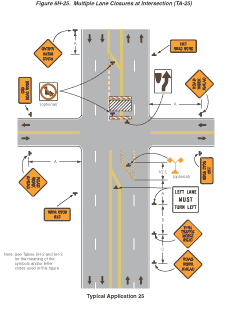
Notes for Figure 6H-26—Typical Application 26
Closure in Center of Intersection
Guidance:
- All lanes should be a minimum of 3 m (10 ft)
in width as measured to the near face of the channelizing devices.
Option:
- A high-level warning device may be placed in
the work space, if there is sufficient room.
- For short-term use on low-volume, low-speed roadways with vehicular
traffic that does not include longer and wider heavy commercial
vehicles, a minimum lane width of 2.7 m (9 ft) may be used.
- Flashing warning lights and/or flags may be used
to call attention to advance warning signs.
- Unless the streets are wide, it may be physically
impossible to turn left, especially for large vehicles. Left turns
may be prohibited as required by geometric conditions.
- For short-duration work operations, the channelizing
devices may be eliminated if a vehicle displaying high-intensity
rotating, flashing, oscillating, or strobe lights is positioned
in the work space.
- Vehicle hazard warning signals may be used to
supplement high-intensity rotating, flashing, oscillating, or
strobe lights.
Standard:
- Vehicle hazard warning signals shall not be
used instead of the vehicle’s high-intensity rotating, flashing,
oscillating, or strobe lights.
Figure
6H-26 Closure in Center of Intersection (TA-26)
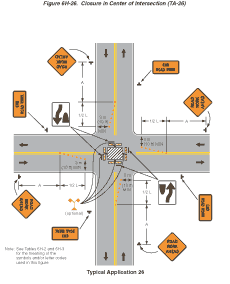
Notes for Figure 6H-27—Typical Application 27
Closure at Side of Intersection
Guidance:
- The situation depicted can be simplified by
closing one or more of the intersection approaches. If this cannot
be done, and/or when capacity is a problem, through vehicular
traffic should be directed to other roads or streets.
- Depending on road user conditions, flagger(s)
or uniformed law enforcement officer(s) should be used to direct
road users within the intersection.
Standard:
- At night, flagger stations shall be illuminated,
except in emergencies.
Option:
- ONE LANE ROAD AHEAD signs may also be used to
provide adequate advance warning.
- Flashing warning lights and/or flags may be used
to call attention to the advance warning signs.
- For short-duration work operations, the channelizing
devices may be eliminated if a vehicle displaying high-intensity
rotating, flashing, oscillating, or strobe lights is positioned
in the work space.
- A BE PREPARED TO STOP sign may be added to the
sign series.
Guidance:
- When used, the BE PREPARED TO STOP sign should
be located before the Flagger symbol sign.
Support:
- Turns can be prohibited as required by vehicular
traffic conditions. Unless the streets are wide, it might be physically
impossible to make certain turns, especially for large vehicles.
Option:
- Vehicle hazard warning signals may be used to
supplement high-intensity rotating, flashing, oscillating, or
strobe lights.
Standard:
- Vehicle hazard warning signals shall not be
used instead of the vehicle’s high-intensity rotating, flashing,
oscillating, or strobe lights.
Figure
6H-27 Closure at Side of Intersection (TA-27)

Notes for Figure 6H-28—Typical Application 28
Sidewalk Closures and Bypass Sidewalks
Standard:
- When crosswalks or other pedestrian facilities
are closed or relocated, temporary facilities shall be detectable
and shall include accessibility features consistent with the features
present in the existing pedestrian facility.
Guidance:
- Where high speeds are anticipated, a temporary
traffic barrier and, if necessary, a crash cushion should be used
to separate the temporary sidewalks from vehicular traffic.
- Audible information devices should be considered
where midblock closings and changed crosswalk areas cause inadequate
communication to be provided to pedestrians who have visual disabilities.
Option:
- Street lighting may be considered.
- Only the TTC devices related to pedestrians are
shown. Other devices, such as lane closure signing or ROAD NARROWS
signs, may be used to control vehicular traffic.
- For nighttime closures, Type A Flashing warning
lights may be used on barricades that support signs and close
sidewalks.
- Type C Steady-Burn or Type D 360-degree Steady-Burn
warning lights may be used on channelizing devices separating
the temporary sidewalks from vehicular traffic flow.
- Signs, such as KEEP RIGHT (LEFT), may be placed
along a temporary sidewalk to guide or direct pedestrians.
Figure
6H-28 Sidewalk Detour or Diversion (TA-28)
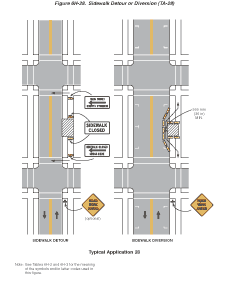
Notes for Figure 6H-29—Typical Application 29
Crosswalk Closures and Pedestrian Detours
Standard:
- When crosswalks or other pedestrian facilities
are closed or relocated, temporary facilities shall be detectable
and shall include accessibility features consistent with the features
present in the existing pedestrian facility.
- Curb parking shall be prohibited for at least
15 m (50 ft) in advance of the midblock crosswalk.
Guidance:
- Audible information devices should be considered
where midblock closings and changed crosswalk areas cause inadequate
communication to be provided to pedestrians who have visual disabilities.
- Pedestrian traffic signal displays controlling
closed crosswalks should be covered or deactivated.
Option:
- Street lighting may be considered.
- Only the TTC devices related to pedestrians are
shown. Other devices, such as lane closure signing or ROAD NARROWS
signs, may be used to control vehicular traffic.
- For nighttime closures, Type A Flashing warning
lights may be used on barricades supporting signs and closing
sidewalks.
- Type C Steady-Burn warning lights may be used
on channelizing devices separating the work space from vehicular
traffic.
- In order to maintain the systematic use of the
fluorescent yellow-green background for pedestrian, bicycle, and
school warning signs in a jurisdiction, the fluorescent yellow-green
background for pedestrian, bicycle, and school warning signs may
be used in TTC zones.
Figure
6H-29 Crosswalk Closures and Pedestrian Detours (TA-29)

Notes for Figure 6H-30—Typical Application 30
Interior Lane Closure on Multi-lane Street
Guidance:
- This information applies to low-speed, low-volume
urban streets. Where speed or volume is higher, additional signing
such as LEFT LANE CLOSED XX m (FT) should be used between the
signs shown.
Option:
- The closure of the adjacent interior lane in
the opposing direction may not be necessary, depending upon the
activity being performed and the work space needed for the operation.
- Shadow vehicles with a truck-mounted attenuator
may be used.
Guidance:
- When a highway-rail grade crossing exists within
or upstream of the transition area and it is anticipated that
backups resulting from the lane closure might extend through the
highway-rail grade crossing, the TTC zone should be extended so
that the transition area precedes the highway-rail grade crossing.
- Early coordination with the railroad company
should occur before work starts.
Figure
6H-30 Interior Lane Closure on Multi-lane Street (TA-30)

Notes for Figure 6H-31—Typical Application 31
Lane Closure on Street with Uneven Directional Volumes
Standard:
- The illustrated information shall be used only
when the vehicular traffic volume indicates that two lanes of
vehicular traffic shall be maintained in the direction of travel
for which one lane is closed.
Option:
- The procedure may be used during a peak period
of vehicular traffic and then changed to provide two lanes in
the other direction for the other peak.
Guidance:
- For high speeds, a LEFT LANE CLOSED XX m (FT)
sign should be added for vehicular traffic approaching the lane
closure, as shown in Figure 6H-32.
- Conflicting pavement markings should be removed
for long-term projects. For short-term and intermediate-term projects
where this is not practical, the channelizing devices in the area
where the pavement markings conflict should be placed at a maximum
spacing of 0.1 S m (0.5 S ft) where S is the speed in km/h (mph).
Temporary markings should be installed where needed.
- If the lane shift has curves with recommended
speeds of 50 km/h (30 mph) or less, Reverse Turn signs should
be used.
- Where the shifted section is long, a Reverse
Curve sign should be used to show the initial shift and a second
sign should be used to show the return to the normal alignment.
- If the tangent distance along the temporary
diversion is less than 180 m (600 ft), the Double Reverse Curve
sign should be used at the location of the first Two Lane Reverse
Curve sign. The second Two Lane Reverse Curve sign should be omitted.
Option:
- A longitudinal buffer space may be used in the
activity area to separate opposing vehicular traffic.
- An ALL LANES THRU supplemental plaque may be
used to emphasize the point that all lanes shift and no lanes
are closed.
- A work vehicle or a shadow vehicle may be equipped
with a truck-mounted attenuator.
Figure
6H-31 Lane Closure on Street with Uneven Directional Volumes
(TA-31)

Notes for Figure 6H-32—Typical Application 32
Half Road Closure on Multi-lane, High-Speed Highway
Standard:
- Pavement markings no longer applicable shall
be removed or obliterated as soon as practical. Except for intermediate-term
and short-term situations, temporary markings shall be provided
to clearly delineate the temporary travel path. For short-term
and intermediate-term situations where it is not feasible to remove
and restore pavement markings, channelization shall be made dominant
by using a very close device spacing.
Guidance:
- When paved shoulders having a width of 2.4
m (8 ft) or more are closed, channelizing devices should be used
to close the shoulder in advance of the merging taper to direct
vehicular traffic to remain within the traveled way.
- Where channelizing devices are used instead
of pavement markings, the maximum spacing should be 0.1 S meters
where S is the speed in km/h (0.5 S feet where S is the speed
in mph).
- If the tangent distance along the temporary diversion is more
than 180 m (600 ft), a Reverse Curve sign, left first, should
be used instead of the Double Reverse Curve sign, and a second
Reverse Curve sign, right first, should be placed in advance of
the second reverse curve back to the original alignment.
Option:
- Warning lights may be used to supplement channelizing
devices at night.
Guidance:
- When a highway-rail grade crossing exists within
or upstream of the merging taper and it is anticipated that backups
resulting from the lane closure might extend through the highway-rail
grade crossing, the TTC zone should be extended so that the merging
taper precedes the highway-rail grade crossing.
- When a highway-rail grade crossing exists within
the activity area, provisions should be made to provide road users
operating on the left side of the normal centerline with comparable
warning devices as supplied for road users operating on the right
side of the normal centerline.
- When a highway-rail grade crossing exists within
the activity area, early coordination with the railroad company
should occur before work starts.
Option:
- When a highway-rail grade crossing exists within
the activity area, a flagger may be used at the highway-rail grade
crossing to minimize the probability that vehicles are stopped
within 4.6 m (15 ft) of the highway-rail grade crossing, measured
from both sides of the outside rails.
- A truck-mounted attenuator may be used on the
work vehicle and/or the shadow vehicle.
Figure
6H-32 Half Road Closure on Multilane, High-Speed Highway (TA-32)
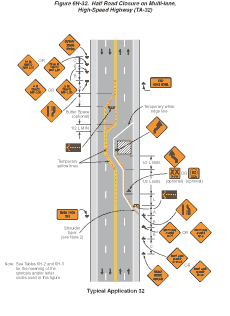
Notes for Figure 6H-33—Typical Application 33
Stationary Lane Closure on Divided Highway
Standard:
- This information also shall be used when work
is being performed in the lane adjacent to the median on a divided
highway. In this case, the LEFT LANE CLOSED signs and the corresponding
Lane Ends signs shall be substituted.
- When a side road intersects the highway within
the TTC zone, additional TTC devices shall be placed as needed.
Guidance:
- When paved shoulders having a width of 2.4
m (8 ft) or more are closed, channelizing devices should be used
to close the shoulder in advance of the merging taper to direct
vehicular traffic to remain within the traveled way.
Option:
- A truck-mounted attenuator may be used on the
work vehicle and/or shadow vehicle.
Support:
- Where conditions permit, restricting all vehicles,
equipment, workers, and their activities to one side of the roadway
might be advantageous.
Figure
6H-33 Stationary Lane Closure on Divided Highway (TA-33)
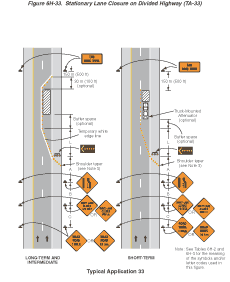
Notes for Figure 6H-34—Typical Application 34
Lane Closure with Temporary Traffic Barrier
Standard:
- This information also shall be used when work
is being performed in the lane adjacent to the median on a divided
highway. In this case, the LEFT LANE CLOSED signs and the corresponding
Lane Ends signs shall be substituted.
Guidance:
- For long-term lane closures on facilities with
permanent edge lines, a temporary edge line should be installed
from the start of the merging taper to the far end of the downstream
taper, and conflicting pavement markings should be removed.
- The use of a barrier should be based on engineering
judgment.
Standard:
- Where temporary traffic barriers are installed,
the ends of the barrier shall be treated in accordance with the
provisions of Section 6F.81.
- The barrier shall not be placed along the merging
taper. The lane shall first be closed using channelizing devices
and pavement markings.
Option:
- The barrier shown in this typical application
is an example of one method that may be used to close a lane for
a long-term project. If the work activity permits, a movable barrier
may be used and relocated to the shoulder during nonwork periods
or peak-period vehicular traffic conditions, as appropriate.
- Type C Steady-Burn warning lights may be placed
on channelizing devices and the barrier parallel to the edge of
pavement for nighttime lane closures.
Standard:
- If a movable barrier is used, the temporary
white edge line shown in the typical application shall not be
used. During the period when the right lane is opened, the sign
legends and the channelization shall be changed to indicate that
only the shoulder is closed, as illustrated in Figure
6H-5. The arrow panel, if used, shall be placed at the end
of the shoulder taper and shall display the caution mode.
Guidance:
- If a movable barrier is used, the shift should
be performed in the following manner. When closing the lane, the
lane should be initially closed with channelizing devices placed
along a merging taper using the same information employed for
a stationary lane closure. The lane closure should then be extended
with the movable-barrier transfer vehicle moving with vehicular
traffic. When opening the lane, the movable-barrier transfer vehicle
should travel against vehicular traffic from the termination area
to the transition area. The merging taper should then be removed
using the same information employed for a stationary lane closure.
Figure
6H-34 Lane Closure with Temporary Traffic Barrier (TA-34)
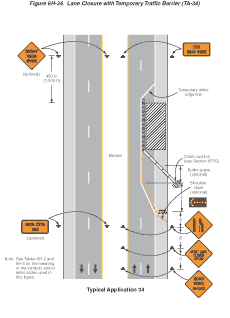
Notes for Figure 6H-35—Typical Application 35
Mobile Operation on Multi-lane Road
Standard:
- Arrow panels shall, as a minimum, be Type B,
with a size of 1500 x 750 mm (60 x 30 in).
Guidance:
- Vehicles used for these operations should be
made highly visible with appropriate equipment, such as: high-intensity
rotating, flashing, oscillating, or strobe lights, flags, signs,
or arrow panels.
- Shadow Vehicle 1 should be equipped with an
arrow panel and truck-mounted attenuator.
- Shadow Vehicle 2 should be equipped with an
arrow panel. An appropriate lane closure sign should be placed
on Shadow Vehicle 2 so as not to obscure the arrow panel.
- Shadow Vehicle 2 should travel at a varying
distance from the work operation so as to provide adequate sight
distance for vehicular traffic approaching from the rear.
- The spacing between the work vehicles and the
shadow vehicles, and between each shadow vehicle should be minimized
to deter road users from driving in between.
- Work should normally be accomplished during
off-peak hours.
- When the work vehicle occupies an interior
lane (a lane other than the far right or far left) of a directional
roadway having a right shoulder 3 m (10 ft) or more in width,
Shadow Vehicle 2 should drive the right shoulder with a sign indicating
that work is taking place in the interior lane.
Option:
- A truck-mounted attenuator may be used on Shadow
Vehicle 2.
- On high-speed roadways, a third shadow vehicle
(not shown) may be used with Shadow Vehicle 1 in the closed lane,
Shadow Vehicle 2 straddling the edge line, and Shadow Vehicle
3 on the shoulder.
- Where adequate shoulder width is not available,
Shadow Vehicle 3 may drive partially in the lane.
Figure
6H-35 Mobile Operation on Multi-lane Road (TA-35)
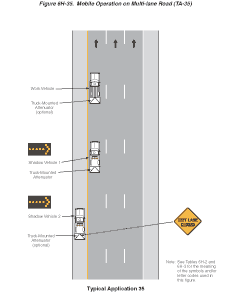
Back to Top
|

